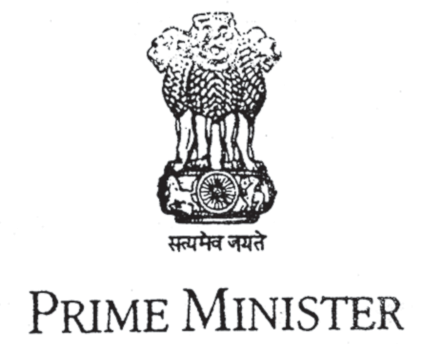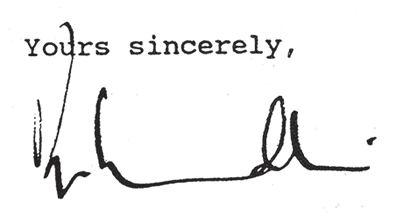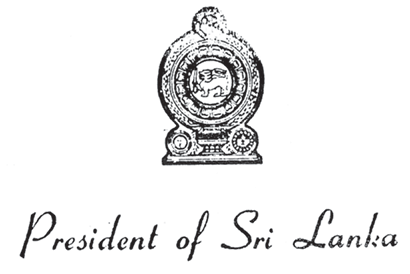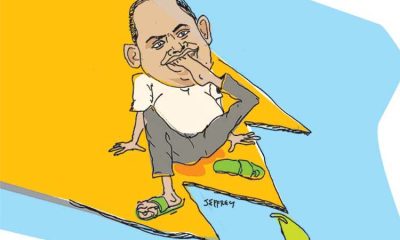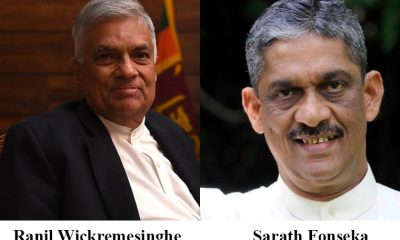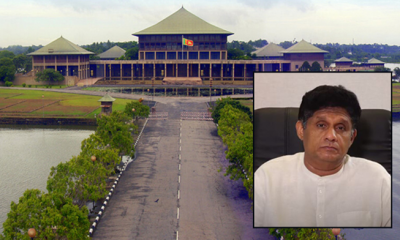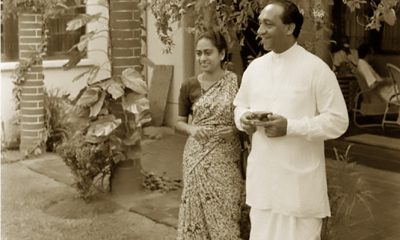Features
IPKF’S Withdrawal: Correspondence between Premadasa and Rajiv Gandhi – Part II
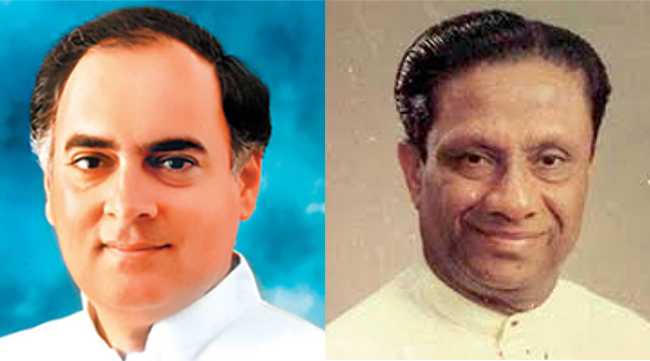
ANNEXURE “H”
New Delhi
July 11, 1989
Dear Mr. President,
I have your letters of 30th June and 5th July.
I do not wish to enter into a debate on various interpretations of mutual obligations assumed by our two sovereign nations. These are quite clear. I also do not wish to go into the validity of assertions like the LTTE having resumed violence on 2nd August, 1987 whereas the arms surrender started and the amnesty letter was handed over by the Sri Lankan Government to the LTTE three days later. We should let facts speak for themselves.
There is an Agreement between our two countries. This Agreement is meant to preserve the unity and integrity of Sri Lanka and to ensure the safety, security and legitimate interests of the Tamils. Nearly a thousand Indian soldiers have made the supreme sacrifice in fulfilment of India’s obligations as a guarantor of this Agreement. Since the signing of the Agreement, not only have the Provincial Council elections been held, but also the Parliamentary and Presidential elections. The situation in the North-Eastern Province is far more settled and peaceful than elsewhere in Sri Lanka. Despite all this, the devolution package promised to the Tamils has not been implemented. These are incontrovertible facts.
Both of us agree that the IPKF should be withdrawn. Both of us agree that we had commenced the withdrawal even before you asked for it. A broad time frame for IPKF’s withdrawal had in fact been discussed. Discussions on finalising the details were proposed by your Foreign Minister at Harare only a few days prior to your unilateral announcement of 1st June.
I have repeatedly said that the IPKF’s withdrawal schedule should be worked out through joint consultations along with a simultaneous schedule for the implementation of the Indo-Sri Lanka Agreement. We are willing to resume discussions on, this subject at any time and place of your convenience. Your colleague, the Honourable Mr. Thondaman, who met me here, would have conveyed to you our desire for friendly relations and our willingness to resolve any misunderstandings through mutual consultations. If, however, discussions for this purpose are not acceptable to you, we will have to decide the details of IPKF’s withdrawal unilaterally consistent with our responsibilities and obligations under the Indo-Sri Lanka Agreement.
While I reiterate Government of India’s willingness to cooperate with your Government to resolve pending issues, I must emphasise to Your Excellency that India has traditionally been mindful of the sanctity of the Agreements it signs with other countries and of commitments solemnly undertaken under such Agreements. India will under no circumstances deviate from this policy affecting our concerns.
It has been our practice to maintain the confidentiality of official correspondence, particularly ‘between Heads of State or Government, unless otherwise agreed upon. However, the gist of your messages to me was more often than not made available to the media before they reached me. Now I find that all our recent correspondence has been officially made public by the Sri Lanka Government. I may thus be constrained to depart from tradition by authorising this communication being made public, after you receive it.
His Excellency
Mr. Ranasinghe Premadasa
President of the Democratic Socialist Republic of Sri Lanka
Colombo
ANNEXURE “I” 12th July 1989
Dear Prime Minister
I am in receipt of your letter of 11th July 1989 which was handed-to me by your Special-Envoy.I thank you for the courtesy of sending him to Sri Lanka in an attempt to resolve the issues regarding the withdrawal of the Indian Armed Forces.
I explained to your Special Envoy and his delegation my position with-regard to the withdrawal of the Indian Armed Forces from Sri Lanka. I informed them that the discussions can continue based on the four premises set out below.
Firstly, the Indian Armed Forces arrived in Sri Lanka as a peace keeping force to assist in restoring peace. They came at the request of the President of Sri Lanka and were under his command as the Commander in Chief of the Forces of Armed Forces. Their invitation was in terms of Item 6 of the Annexure to the Indo-Sri Lanka agreement which says “that an Indian Peace Keeping Contingent may be invited by the President of Sri Lanka to guarantee and enforce the cessation of hostilities if so required.” The fact that the president of Sri Lanka is the Commander in Chief of all Armed Forces in Sri Lanka has been recognised by the Government of India.
Secondly, the Agreement was between the Government of Sri Lanka and the Government of India. There were no other parties to the Agreement. In fact the LTTE protested that they were left out of the Agreement and in fact their leaders had been confined for a duration of time leading up to the signing of the Agreement.
Thirdly, the presence of the Indian Armed Forces and the devolution of powers to the Provincial Councils are totally unconnected. I have explained this to you at great length in my earlier communications. I have told your delegation that the devolution of power by the Sri Lanka Parliament is entirely an internal matter. No foreign agency can oversee the implementation of legislation enacted by or compel the Parliament of a sovereign State to enact any particular provision of law. In any case, as stated in my earlier letter of 30th June 1989 you would appreciate that devolution is essentially a long term process. There is neither any legal nor any other rational basis for the presence of any military force to ensure that the process of devolution is complete. It would therefore be incorrect and unrealistic to contend that the Indian Armed Forces were expected to remain in Sri Lanka till the process of devolution is completed.
Fourthly, the Government of India undertook not to permit Indian territory to be used for activities prejudicial to the unity, integrity and security of Sri Lanka. I was constrained to point out to your delegation that Mr Padmanabha and others who are campaigning to keep the Indian Armed Forces in Sri Lanka have not only been permitted to publicly express their intention of making a unilateral declaration of Eelam whilst being on Indian soil but also to publicise such declaration on Indian national television.
I explained further to them that the invitation extended to the Indian Armed Forces was based on assurances contained in the Agreement that the time frame required for cessation of hostilities was 48 hours from the signing of the Agreement and for the surrender of arms was 72 hours from the cessation of hostilities. You would also appreciate that the decision to invite an Indian peace Keeping Contingent was in the context of resolve that a solution to the ethnic problem should be through negotiation and not by the use of military force. As such, the invitation could not have been interpreted as being one for the Indian Peace Keeping Contingent to engage itself in the prolonged use of force.
The reassurance with which I noted the withdrawal of Indian force when I assumed office turned to disappointment when I observed that the withdrawal was not being effected as expeditiously as possible. After careful consideration I decided that the 31st July 1989 was the suitable deadline for the withdrawal of the Indian armed forces from Sri Lanka.
The President of Sri Lanka could under Article 2.16(c) of the Agreement obtain Indian military -assistance when he thinks such assistance is necessary. In my Election Manifesto I promised to solve the problem, not by the use of force but by a process of consultation, compromise and consensus. The people of this country endorsed this manifesto. The dialogue initiated under this mandate has already borne fruit. The LTTE once the most intractable of the militant groups has ceased hostilities not only against the Government, but against all the people of the North and the East and indeed against all the people of Sri Lanka. They have agreed to join the democratic process and are now committed to settling problems by negotiation. In this context continued military action by the Indian armed forces is not only unnecessary but also prejudicial to a settlement by discussion and negotiation.
Action by the Indian armed forces is also gravely prejudicial to a political settlement with the LTTE who assert their need to carry arms as long as they are being attacked by the Indian forces and other militant groups who reportedly, enjoy the support of the Indian forces. Further the very presence of the Indian armed forces in Sri Lanka has made it difficult for me to enter into any dialogue with other political groups. In the meantime, certain groups in other parts of the country are resorting to violent activity on account of what they claim to be the inability of the Government to ensure the withdrawal of the Indian armed forces. The continued presence of the Indian armed forces is driving these groups to escalating their violence to crisis proportions.
My officials will be holding discussions based on these basic premises. I shall be replying the other issues including the statement attributed to my Foreign Minister raised in your letter of 11th July 1989 at the conclusion of the discussions between your delegation and my officials.
Yours sincerely
PRESIDENT
ANNEXURE “J”
19 July 1989
Dear Prime Minister
Further to my letter of 12th July, 1989 I wish to clarify certain matters referred to in your letter of 11th July, 1989.I agree that we should not enter into a debate. The terms of the Agreement are clear. The events leading up to that Agreement and the subsequent developments are fresh in our minds.
In regard to the cessation of hostilities by the LTTE, it is a fact that the Indian Armed Forces in Sri Lanka had not been able, even after two years, to ensure such cessation and complete disarming the militants. At the time of the signing of the Agreement it was envisaged that this process would not take more than five days.
I also agree with your assertion that the Agreement involves the acceptance of mutual obligations by two sovereign and friendly nations. The objective of this Agreement was to resolve the ethnic problem and to end the violence that was a threat to the unity and territorial integrity of Sri Lanka. The Agreement also sought to ensure the physical security and safety not only of the Tamil ethnic community but of all communities inhabiting the Northern and Eastern Provinces.
I must thank you once again for the assistance provided by the Indian Forces in response to Sri Lanka’s request for military assistance to guarantee and enforce the cessation of hostilities. We are sad that over a thousand Indian lives have been lost.
Sri Lanka for her part has discharged all her obligations under the Agreement and in particular taken all effective and meaningful steps towards the devolution of power.Sri Lanka has amongst other things, amended the Constitution, enacted legislation necessary to establish Provincial Councils, temporarily merged the Northern and Eastern Provinces, implemented the Official Languages policy, held the Provincial Council Elections, set up the infrastructure and provided the personnel and finances necessary for effective functioning.
I wish to reiterate that I have at all times held the view that the problems of the Tamil linguistic groups in Sri Lanka should be resolved, not by the use of force but by the process of consultation, compromise and consensus.Firm in this belief, I, as the Presidential Candidate, incorporated in my manifesto a pledge to secure the withdrawal of the Indian Armed Forces as a necessary prelude to political negotiations and a durable settlement. I did so in October/November 1988. The people of Sri Lanka, by an overwhelming majority endorsed this principle, both at the Presidential and Parliamentary Elections.
The events of the past months have proved the wisdom of my approach. The LTTE once the most intractable of groups have now agreed to eschew violence and join the mainstream of political democracy.You state that “the situation in the North-Eastern Provinces is far more settled and peaceful than elsewhere in Sri Lanka.” If this be so, there would be a lesser need for offensive action by the armed forces in these areas.
Furthermore, the substantial grievance over which the other Provinces began fomenting unrest, is the continued presence of the Indian Armed Forces in Sri Lanka. As you are aware, the agitation commenced with the signing of the Agreement and continued to escalate due to the presence of the Indian Armed Forces. So that, which ever way it is looked at, the continued presence of the Indian Armed Forces is an obstacle to the restoration of peace and normalcy in Sri Lanka.
Whilst we are both agreed that the Indian Armed Forces in Sri Lanka should be withdrawn, I cannot, for the reasons more fully set out in the annex hereto, agree that the terms of the Agreement do, or can in law be interpreted to mean, that the withdrawal of the Indian Armed Forces is in any way linked with or preconditioned upon the implementation of the process of devolution, or for that matter, the performance of any other obligation cast upon Sri Lanka by the Agreement.
The continued presence of the Indian Armed Forces or the conduct of any operations by such forces within Sri Lankan territory, is conditional only upon the concurrence of the Sri Lanka Government. It would therefore be unlawful for the Government of India to continue to maintain her Armed Forces within Sri Lankan territory in the absence of such concurrence.
It would be incompatible with the sovereignty of a State to concede a right for any alien armed force to operate within its territory contrary to the wishes of the Head of State who is also the Commander-in-Chief of its forces – from whom such alien armed force is not taking orders.
You would also appreciate that any continued offensive action against a section of my people who have publicly announced a cessation of hostilities against the Government and all the people of Sri Lanka would amount to the unlawful taking of civilian lives.
As already intimated to you, with the recommencement of the withdrawal process it will be possible to set in motion consultations to accommodate any logistical constraints which may arise.You have stated that my Foreign Minister has discussed a broad time frame for the withdrawal of the IPKF. According to him the former Indian High Commissioner in Colombo had intimated that some of the IPKF would be withdrawn by 30th of June and the rest by 31st of December. It appears that this had been a tentative proposal made by your former High Commissioner and I must emphasise that we have not at any time agreed to such a time frame.
I continue to receive reports of the forcible conscription of young people in the Northern and Eastern Provinces and their training at the hands of the Indian Forces. Since I wrote to you on this matter on 30th June, the situation has been aggravated. There is now an exodus of young people from the Northern and the Eastern Provinces fleeing from this conscription. A sizeable number is being accommodated in camps in Colombo.
I am thankful for the assurance in your letter that India has traditionally been mindful of the sanctity of the principle of observing the obligations of Agreements entered into by India. I wholly endorse the principle that Agreements should be observed. In this regard I invite your attention to the express provision in the Indo-Sri Lanka Agreement that the provision of military assistance by the Government of India is “as and when requested” by the Government of Sri Lanka.
It should also be noted that the Agreement contemplates that the Indian Armed Forces will assist the Government of Sri Lanka and. not be operating on their own initiative.
However, if it is your view that the Agreement should be construed as creating an obligation for the Indian Armed Forces to remain in Sri Lankan territory without the concurrence and against the express wishes of the Sri Lanka Government, I as the President of an independent, sovereign Republic, would have no option but to treat the Agreement as being inimical to Sri Lanka’s sovereignty and national interests.
PRESIDENT
His Excellency Shri Rajiv Gandhi
Prime Minister of India Prime Minister’s Office New Delhi
India.
ANNEX
The entry into and the continued presence of Indian Armed Forces on Sri Lankan territory can be lawful only upon the express concurrence of the Government of Sri Lanka.
It is a peremptory norm of international law, that the presence of, or the conduct of operations by, any foreign armed force within the territory of a sovereign state, otherwise than with the express concurrence of the Government of that state amounts to an act of aggression. Such acts of aggression have not only been recognized as unlawful, but unequivocally condemned by the community of civilized nations. This principle has also been reiterated in several United Nations instruments.
In the Indo-Sri Lanka Agreement several acts of co-operation are obligated upon the Government of India. The provision of military assistance is one such act of co-operation.An examination of the structure of the Agreement makes it clear, that the Agreement contemplated implementation without the use of force, that the Government of India, agreed to underwrite and guarantee the acceptance of the Agreement by the militant groups, who would then cease hostilities and surrender their arms.
The Government of Sri Lanka undertook to confine its ‘Armed Forces to barracks and to grant an Amnesty to the militants who were in custody.The rendering of military assistance is governed by Article 2.16 (c) which clearly stipulates that the affording of military assistance is “as and when” requested by the Government of Sri Lanka.
This Article makes it clear beyond argument, that the basic provision of international law regarding the necessity of the concurrence of the government of the domestic state in the entry of foreign armed forces into its territory, has been recognized and observed.
With the release of the militants from custody and the confining of the Armed Forces to barracks by Sri Lanka, and the failure to disarm the militants or to ensure cessation of hostilities, there was resumption of the violence which necessitated the request t for Indian military Assistance. Accordingly the invitation to the Indian Armed Forces was, as unequivocally stated in clause 6 of the Annexure, “to guarantee and enforce the cessation of hostilities”.
Any attempt to” construe this invitation as providing a mandatory’ right for the Armed Forces so invited to “protect” minorities or to oversee the devolution of power would be an untenable construction of the Agreement.Such a construction would neither accord with the clear understanding stated in the Agree-sent nor with the peremptory norms of international law.
Features
The heart-friendly health minister

by Dr Gotabhya Ranasinghe
Senior Consultant Cardiologist
National Hospital Sri Lanka
When we sought a meeting with Hon Dr. Ramesh Pathirana, Minister of Health, he graciously cleared his busy schedule to accommodate us. Renowned for his attentive listening and deep understanding, Minister Pathirana is dedicated to advancing the health sector. His openness and transparency exemplify the qualities of an exemplary politician and minister.
Dr. Palitha Mahipala, the current Health Secretary, demonstrates both commendable enthusiasm and unwavering support. This combination of attributes makes him a highly compatible colleague for the esteemed Minister of Health.
Our discussion centered on a project that has been in the works for the past 30 years, one that no other minister had managed to advance.
Minister Pathirana, however, recognized the project’s significance and its potential to revolutionize care for heart patients.
The project involves the construction of a state-of-the-art facility at the premises of the National Hospital Colombo. The project’s location within the premises of the National Hospital underscores its importance and relevance to the healthcare infrastructure of the nation.
This facility will include a cardiology building and a tertiary care center, equipped with the latest technology to handle and treat all types of heart-related conditions and surgeries.
Securing funding was a major milestone for this initiative. Minister Pathirana successfully obtained approval for a $40 billion loan from the Asian Development Bank. With the funding in place, the foundation stone is scheduled to be laid in September this year, and construction will begin in January 2025.
This project guarantees a consistent and uninterrupted supply of stents and related medications for heart patients. As a result, patients will have timely access to essential medical supplies during their treatment and recovery. By securing these critical resources, the project aims to enhance patient outcomes, minimize treatment delays, and maintain the highest standards of cardiac care.
Upon its fruition, this monumental building will serve as a beacon of hope and healing, symbolizing the unwavering dedication to improving patient outcomes and fostering a healthier society.We anticipate a future marked by significant progress and positive outcomes in Sri Lanka’s cardiovascular treatment landscape within the foreseeable timeframe.
Features
A LOVING TRIBUTE TO JESUIT FR. ALOYSIUS PIERIS ON HIS 90th BIRTHDAY

by Fr. Emmanuel Fernando, OMI
Jesuit Fr. Aloysius Pieris (affectionately called Fr. Aloy) celebrated his 90th birthday on April 9, 2024 and I, as the editor of our Oblate Journal, THE MISSIONARY OBLATE had gone to press by that time. Immediately I decided to publish an article, appreciating the untiring selfless services he continues to offer for inter-Faith dialogue, the renewal of the Catholic Church, his concern for the poor and the suffering Sri Lankan masses and to me, the present writer.
It was in 1988, when I was appointed Director of the Oblate Scholastics at Ampitiya by the then Oblate Provincial Fr. Anselm Silva, that I came to know Fr. Aloy more closely. Knowing well his expertise in matters spiritual, theological, Indological and pastoral, and with the collaborative spirit of my companion-formators, our Oblate Scholastics were sent to Tulana, the Research and Encounter Centre, Kelaniya, of which he is the Founder-Director, for ‘exposure-programmes’ on matters spiritual, biblical, theological and pastoral. Some of these dimensions according to my view and that of my companion-formators, were not available at the National Seminary, Ampitiya.
Ever since that time, our Oblate formators/ accompaniers at the Oblate Scholasticate, Ampitiya , have continued to send our Oblate Scholastics to Tulana Centre for deepening their insights and convictions regarding matters needed to serve the people in today’s context. Fr. Aloy also had tried very enthusiastically with the Oblate team headed by Frs. Oswald Firth and Clement Waidyasekara to begin a Theologate, directed by the Religious Congregations in Sri Lanka, for the contextual formation/ accompaniment of their members. It should very well be a desired goal of the Leaders / Provincials of the Religious Congregations.
Besides being a formator/accompanier at the Oblate Scholasticate, I was entrusted also with the task of editing and publishing our Oblate journal, ‘The Missionary Oblate’. To maintain the quality of the journal I continue to depend on Fr. Aloy for his thought-provoking and stimulating articles on Biblical Spirituality, Biblical Theology and Ecclesiology. I am very grateful to him for his generous assistance. Of late, his writings on renewal of the Church, initiated by Pope St. John XX111 and continued by Pope Francis through the Synodal path, published in our Oblate journal, enable our readers to focus their attention also on the needed renewal in the Catholic Church in Sri Lanka. Fr. Aloy appreciated very much the Synodal path adopted by the Jesuit Pope Francis for the renewal of the Church, rooted very much on prayerful discernment. In my Religious and presbyteral life, Fr.Aloy continues to be my spiritual animator / guide and ongoing formator / acccompanier.
Fr. Aloysius Pieris, BA Hons (Lond), LPh (SHC, India), STL (PFT, Naples), PhD (SLU/VC), ThD (Tilburg), D.Ltt (KU), has been one of the eminent Asian theologians well recognized internationally and one who has lectured and held visiting chairs in many universities both in the West and in the East. Many members of Religious Congregations from Asian countries have benefited from his lectures and guidance in the East Asian Pastoral Institute (EAPI) in Manila, Philippines. He had been a Theologian consulted by the Federation of Asian Bishops’ Conferences for many years. During his professorship at the Gregorian University in Rome, he was called to be a member of a special group of advisers on other religions consulted by Pope Paul VI.
Fr. Aloy is the author of more than 30 books and well over 500 Research Papers. Some of his books and articles have been translated and published in several countries. Among those books, one can find the following: 1) The Genesis of an Asian Theology of Liberation (An Autobiographical Excursus on the Art of Theologising in Asia, 2) An Asian Theology of Liberation, 3) Providential Timeliness of Vatican 11 (a long-overdue halt to a scandalous millennium, 4) Give Vatican 11 a chance, 5) Leadership in the Church, 6) Relishing our faith in working for justice (Themes for study and discussion), 7) A Message meant mainly, not exclusively for Jesuits (Background information necessary for helping Francis renew the Church), 8) Lent in Lanka (Reflections and Resolutions, 9) Love meets wisdom (A Christian Experience of Buddhism, 10) Fire and Water 11) God’s Reign for God’s poor, 12) Our Unhiddden Agenda (How we Jesuits work, pray and form our men). He is also the Editor of two journals, Vagdevi, Journal of Religious Reflection and Dialogue, New Series.
Fr. Aloy has a BA in Pali and Sanskrit from the University of London and a Ph.D in Buddhist Philosophy from the University of Sri Lankan, Vidyodaya Campus. On Nov. 23, 2019, he was awarded the prestigious honorary Doctorate of Literature (D.Litt) by the Chancellor of the University of Kelaniya, the Most Venerable Welamitiyawe Dharmakirthi Sri Kusala Dhamma Thera.
Fr. Aloy continues to be a promoter of Gospel values and virtues. Justice as a constitutive dimension of love and social concern for the downtrodden masses are very much noted in his life and work. He had very much appreciated the commitment of the late Fr. Joseph (Joe) Fernando, the National Director of the Social and Economic Centre (SEDEC) for the poor.
In Sri Lanka, a few religious Congregations – the Good Shepherd Sisters, the Christian Brothers, the Marist Brothers and the Oblates – have invited him to animate their members especially during their Provincial Congresses, Chapters and International Conferences. The mainline Christian Churches also have sought his advice and followed his seminars. I, for one, regret very much, that the Sri Lankan authorities of the Catholic Church –today’s Hierarchy—- have not sought Fr.
Aloy’s expertise for the renewal of the Catholic Church in Sri Lanka and thus have not benefited from the immense store of wisdom and insight that he can offer to our local Church while the Sri Lankan bishops who governed the Catholic church in the immediate aftermath of the Second Vatican Council (Edmund Fernando OMI, Anthony de Saram, Leo Nanayakkara OSB, Frank Marcus Fernando, Paul Perera,) visited him and consulted him on many matters. Among the Tamil Bishops, Bishop Rayappu Joseph was keeping close contact with him and Bishop J. Deogupillai hosted him and his team visiting him after the horrible Black July massacre of Tamils.
Features
A fairy tale, success or debacle

Sri Lanka-Singapore Free Trade Agreement
By Gomi Senadhira
senadhiragomi@gmail.com
“You might tell fairy tales, but the progress of a country cannot be achieved through such narratives. A country cannot be developed by making false promises. The country moved backward because of the electoral promises made by political parties throughout time. We have witnessed that the ultimate result of this is the country becoming bankrupt. Unfortunately, many segments of the population have not come to realize this yet.” – President Ranil Wickremesinghe, 2024 Budget speech
Any Sri Lankan would agree with the above words of President Wickremesinghe on the false promises our politicians and officials make and the fairy tales they narrate which bankrupted this country. So, to understand this, let’s look at one such fairy tale with lots of false promises; Ranil Wickremesinghe’s greatest achievement in the area of international trade and investment promotion during the Yahapalana period, Sri Lanka-Singapore Free Trade Agreement (SLSFTA).
It is appropriate and timely to do it now as Finance Minister Wickremesinghe has just presented to parliament a bill on the National Policy on Economic Transformation which includes the establishment of an Office for International Trade and the Sri Lanka Institute of Economics and International Trade.
Was SLSFTA a “Cleverly negotiated Free Trade Agreement” as stated by the (former) Minister of Development Strategies and International Trade Malik Samarawickrama during the Parliamentary Debate on the SLSFTA in July 2018, or a colossal blunder covered up with lies, false promises, and fairy tales? After SLSFTA was signed there were a number of fairy tales published on this agreement by the Ministry of Development Strategies and International, Institute of Policy Studies, and others.
However, for this article, I would like to limit my comments to the speech by Minister Samarawickrama during the Parliamentary Debate, and the two most important areas in the agreement which were covered up with lies, fairy tales, and false promises, namely: revenue loss for Sri Lanka and Investment from Singapore. On the other important area, “Waste products dumping” I do not want to comment here as I have written extensively on the issue.
1. The revenue loss
During the Parliamentary Debate in July 2018, Minister Samarawickrama stated “…. let me reiterate that this FTA with Singapore has been very cleverly negotiated by us…. The liberalisation programme under this FTA has been carefully designed to have the least impact on domestic industry and revenue collection. We have included all revenue sensitive items in the negative list of items which will not be subject to removal of tariff. Therefore, 97.8% revenue from Customs duty is protected. Our tariff liberalisation will take place over a period of 12-15 years! In fact, the revenue earned through tariffs on goods imported from Singapore last year was Rs. 35 billion.
The revenue loss for over the next 15 years due to the FTA is only Rs. 733 million– which when annualised, on average, is just Rs. 51 million. That is just 0.14% per year! So anyone who claims the Singapore FTA causes revenue loss to the Government cannot do basic arithmetic! Mr. Speaker, in conclusion, I call on my fellow members of this House – don’t mislead the public with baseless criticism that is not grounded in facts. Don’t look at petty politics and use these issues for your own political survival.”
I was surprised to read the minister’s speech because an article published in January 2018 in “The Straits Times“, based on information released by the Singaporean Negotiators stated, “…. With the FTA, tariff savings for Singapore exports are estimated to hit $10 million annually“.
As the annual tariff savings (that is the revenue loss for Sri Lanka) calculated by the Singaporean Negotiators, Singaporean $ 10 million (Sri Lankan rupees 1,200 million in 2018) was way above the rupees’ 733 million revenue loss for 15 years estimated by the Sri Lankan negotiators, it was clear to any observer that one of the parties to the agreement had not done the basic arithmetic!
Six years later, according to a report published by “The Morning” newspaper, speaking at the Committee on Public Finance (COPF) on 7th May 2024, Mr Samarawickrama’s chief trade negotiator K.J. Weerasinghehad had admitted “…. that forecasted revenue loss for the Government of Sri Lanka through the Singapore FTA is Rs. 450 million in 2023 and Rs. 1.3 billion in 2024.”
If these numbers are correct, as tariff liberalisation under the SLSFTA has just started, we will pass Rs 2 billion very soon. Then, the question is how Sri Lanka’s trade negotiators made such a colossal blunder. Didn’t they do their basic arithmetic? If they didn’t know how to do basic arithmetic they should have at least done their basic readings. For example, the headline of the article published in The Straits Times in January 2018 was “Singapore, Sri Lanka sign FTA, annual savings of $10m expected”.
Anyway, as Sri Lanka’s chief negotiator reiterated at the COPF meeting that “…. since 99% of the tariffs in Singapore have zero rates of duty, Sri Lanka has agreed on 80% tariff liberalisation over a period of 15 years while expecting Singapore investments to address the imbalance in trade,” let’s turn towards investment.
Investment from Singapore
In July 2018, speaking during the Parliamentary Debate on the FTA this is what Minister Malik Samarawickrama stated on investment from Singapore, “Already, thanks to this FTA, in just the past two-and-a-half months since the agreement came into effect we have received a proposal from Singapore for investment amounting to $ 14.8 billion in an oil refinery for export of petroleum products. In addition, we have proposals for a steel manufacturing plant for exports ($ 1 billion investment), flour milling plant ($ 50 million), sugar refinery ($ 200 million). This adds up to more than $ 16.05 billion in the pipeline on these projects alone.
And all of these projects will create thousands of more jobs for our people. In principle approval has already been granted by the BOI and the investors are awaiting the release of land the environmental approvals to commence the project.
I request the Opposition and those with vested interests to change their narrow-minded thinking and join us to develop our country. We must always look at what is best for the whole community, not just the few who may oppose. We owe it to our people to courageously take decisions that will change their lives for the better.”
According to the media report I quoted earlier, speaking at the Committee on Public Finance (COPF) Chief Negotiator Weerasinghe has admitted that Sri Lanka was not happy with overall Singapore investments that have come in the past few years in return for the trade liberalisation under the Singapore-Sri Lanka Free Trade Agreement. He has added that between 2021 and 2023 the total investment from Singapore had been around $162 million!
What happened to those projects worth $16 billion negotiated, thanks to the SLSFTA, in just the two-and-a-half months after the agreement came into effect and approved by the BOI? I do not know about the steel manufacturing plant for exports ($ 1 billion investment), flour milling plant ($ 50 million) and sugar refinery ($ 200 million).
However, story of the multibillion-dollar investment in the Petroleum Refinery unfolded in a manner that would qualify it as the best fairy tale with false promises presented by our politicians and the officials, prior to 2019 elections.
Though many Sri Lankans got to know, through the media which repeatedly highlighted a plethora of issues surrounding the project and the questionable credentials of the Singaporean investor, the construction work on the Mirrijiwela Oil Refinery along with the cement factory began on the24th of March 2019 with a bang and Minister Ranil Wickremesinghe and his ministers along with the foreign and local dignitaries laid the foundation stones.
That was few months before the 2019 Presidential elections. Inaugurating the construction work Prime Minister Ranil Wickremesinghe said the projects will create thousands of job opportunities in the area and surrounding districts.
The oil refinery, which was to be built over 200 acres of land, with the capacity to refine 200,000 barrels of crude oil per day, was to generate US$7 billion of exports and create 1,500 direct and 3,000 indirect jobs. The construction of the refinery was to be completed in 44 months. Four years later, in August 2023 the Cabinet of Ministers approved the proposal presented by President Ranil Wickremesinghe to cancel the agreement with the investors of the refinery as the project has not been implemented! Can they explain to the country how much money was wasted to produce that fairy tale?
It is obvious that the President, ministers, and officials had made huge blunders and had deliberately misled the public and the parliament on the revenue loss and potential investment from SLSFTA with fairy tales and false promises.
As the president himself said, a country cannot be developed by making false promises or with fairy tales and these false promises and fairy tales had bankrupted the country. “Unfortunately, many segments of the population have not come to realize this yet”.
(The writer, a specialist and an activist on trade and development issues . )

